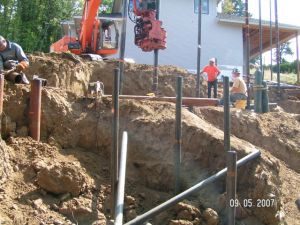What Is Pin Piles
 The technique of pin piling is now several decades old. The system that originated in the US has now spread to other parts of the world, owing to is popularity. The growth was stimulated by the fast developing construction industry in the urban and industrial areas. It is only in the last few years that their full potential has been exploited in terms of load holding capacity. Very heavy loads approaching 700 kips have been recorded for Pin Piles.
The technique of pin piling is now several decades old. The system that originated in the US has now spread to other parts of the world, owing to is popularity. The growth was stimulated by the fast developing construction industry in the urban and industrial areas. It is only in the last few years that their full potential has been exploited in terms of load holding capacity. Very heavy loads approaching 700 kips have been recorded for Pin Piles.
The design and installation of Pin piles
Pin piles provide an exceptional load holding property and can be constructed to considerable depths. The small diameter, bored cast-in-place pin piles are used to underpin structures. They can be used in all types of ground and under very limited access conditions. The method of construction creates a very mammal environmental impact. They can vary from 2- 6 inches in diameter and are often called micro piles or mini piles. The relatively long and slender column of the pin piles is able to resist forces and offer support. The shape and size of the piles can be physically inspected before the installation. The design, installation and quality assurance combine to create a total engineering solution. Removal of any guesswork can contribute to creating a reliable and cost effective product.
Pin piles are typically installed in areas of restricted access and low headroom or restricted access. They are used through difficult and contaminated soils. They are used for soil maintenance and foundation footings. The pin piles are perfect for erecting foundations where there are restraints for physical and geotechnical space. They are simple and easy to use because of their small size. They are used for construction projects with lighter load piling. The requirements for the design and installation of pin piles may vary, depending on the individual task. One needs to keep in mind the space restrictions, the soil conditions when selecting the size and kind of pin pile design. These piles are simply great and a low-priced solution for repairs of foundation.
Performance of Pin piles
More research is being done on how to improve the actual performance of these piles. Full-scale field testing programs are being done in the laboratory and research is being conducted in a variety of materials and with different pile configurations. The progressive interfacial debonding phenomenon is followed to study the elastic performance of the piles. The Elastic Ratio concept has been very useful to analyze and predict Pin Pile performance. There are basically two distinct design methodologies for pin piles, the skin friction or end bearing operations.
The pin-piles are used to underpin foundations and support small to moderate sized structures. Static load tests are performed but can be expensive due to difficulties because of reaction loads and site access. Earlier testis’s show that 60 mm piles can produce 18 kN or higher axial capacities with or elastic shortening or very small pile penetration. Results have demonstrated that results with a small drop weight can create practical correlation with static load test results. This points out that dynamic testing is appropriate for capacity confirmation of pin piles.




